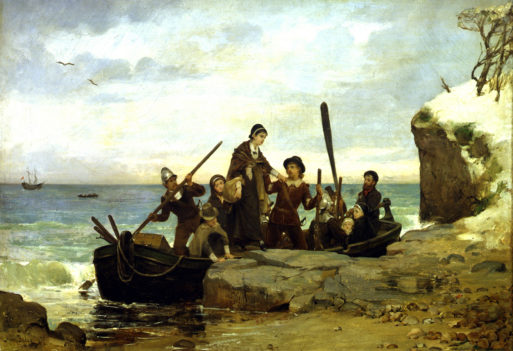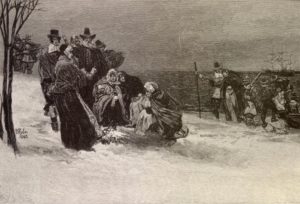For this month’s cultural perspectives post, SevenPonds shares an article from the Connecticut Green Burial Ground’s Merry Burial Blog. Written by Glenn Alan Cheney, the author of Thanksgiving: The Pilgrims’ First Year in America, it is the sad but true story of the Pilgrims of Plymouth’s devastating first winter in America and the struggles they went through to simply bury their dead. As Thanksgiving approaches, it’s a good reminder of the exactly how much our forefathers endured to build the new world.

The Landing of the Pilgrims by Henry Bacon-1877
The Pilgrims of Plymouth had to resort to a particularly sad burial practice during their first winter in the New World. Due to complications getting underway back in England, they didn’t arrive at Plymouth until the middle of November, 1620. It was too late to find a place to live and build houses to get them through the winter. A hundred and two passengers had to spend the next several months in their tight, cold, damp quarters on the gun deck of the Mayflower. Sharing the space with a small sail boat, a few cannons, some farm animals, and bundles of carry-on luggage, they barely had enough room to all lie down at the same time.
In December they started to take sick. They thought it was scurvy, but it was more likely influenza or pneumonia. It afflicted everyone. They were so weak they could hardly get up. When individuals died, they spent days right where they were, right next to people suffering the same symptoms the newly deceased had suffered. William Bradford and Myles Standish were among the few who were able to do anything about the dead.
Removing the corpses was a challenge. They had to be hauled up onto the main deck, then lowered into a boat that could be rowed to shore. It’s also possible the bodies were passed out through small portholes on the gun deck that would have been used for cannon fire in the event of attack.
The landing craft was too big to actually to reach the sandy shore. Those assigned burial duty had to wade the last few yards through the frigid winter water of Cape Cod Bay, dragging the bodies after them.
Since it was winter, the ground beyond the beach was frozen solid. The only alternative was a sandy hill just above the beach, where the sand could be easily dug. So there they opened the graves, and not very deep. “Six feet under” wasn’t a requirement then any more than it is today. And of course it would have been impossible to build coffins. impossible. It’s unlikely the bodies were even wrapped in a shroud.
There were Indians in the area, and in one skirmish shortly after the Mayflower arrived, the Americans and immigrants exchanged gunfire and a barrage of arrows. The Pilgrims had reason to worry, and by January they had reason to hide the fact that they were dying off at a rapid rate. So once a dearly departed had been laid to rest, the burial crew smoothed off the sand to make it look like plain, unconsecrated beach. Nothing marked the spot, not even a cross. By spring, nobody knew exactly who was where. Not that it mattered. Their bodies were to be at one with nature, their souls departed to wherever it was that Pilgrim souls went.

 The Sad, Green Burial of Pilgrims in 1620
The Sad, Green Burial of Pilgrims in 1620



 “Help Me, Helen”
“Help Me, Helen”
 Recovering Cremation Remains After the Los Angeles Fires
Recovering Cremation Remains After the Los Angeles Fires
 “As Tears Go By” by Marianne Faithfull
“As Tears Go By” by Marianne Faithfull














